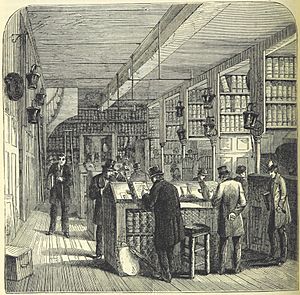Doctors' Commons facts for kids
Doctors' Commons, also known as the College of Civilians, was a special group of lawyers in London. These lawyers practiced a type of law called civil law. This was different from the more common "common law" used in England. Civil law mainly dealt with church matters (ecclesiastical law) and sea matters (admiralty law).
Just like the Inns of Court where common lawyers trained and worked, Doctors' Commons had its own buildings. Members lived and worked there, and they had a big library. It was also a place where smaller legal cases were heard. The lawyers here often went on to judge bigger cases in courts like the Court of the Arches or Admiralty Court. The society used St Benet's, Paul's Wharf as its church.
Contents
What Was Civil Law in England?

Even though English law mostly grew on its own, some special courts used civil law. This type of law was based on ancient Roman law. Church courts, for example, used civil law. Even after the English Reformation, their rules came from the canon law of the Roman Catholic Church. Courts dealing with sea matters (admiralty courts) also used civil law.
Before the 1800s, church courts handled things like wills and family issues. These were similar to today's probate courts and family courts. However, getting a divorce was much harder back then.
The lawyers who worked in these civil law courts were trained at Oxford and Cambridge universities. They studied canon law (church law) and Roman law. This profession had two main roles, much like common law. The "advocates" (also called "doctors") were like barristers. They argued cases in court. The "proctors" were like solicitors. They prepared the cases and dealt with clients.
Some people say Doctors' Commons started in 1511. It was possibly founded by Richard Blodwell, who was a church leader. Other stories suggest it existed even earlier. The society got its main buildings in 1567. They were near St. Paul's Cathedral in London. Later, they used buildings on Knightrider Street.
In 1768, the society became an official organization. Its full name was the "College of Doctors of Law exercent in the Ecclesiastical and Admiralty Courts." The college was led by the Dean of Arches. Its members were doctors of law from Oxford or Cambridge. They were chosen to be "fellows" after being approved by the archbishop of Canterbury. There were also 34 "proctors" who helped with the legal work.
Why Doctors' Commons Ended
By the 1800s, Doctors' Commons and its members seemed old-fashioned. People thought it might be shut down soon. Because of this, the society stopped letting new members join. They wanted to make sure that if the property was sold, the money would be split among fewer people. Dr Thomas Hutchinson Tristram was the very last person to become a member.
In 1857, a new law called the Court of Probate Act 1857 changed things a lot. It took away the church courts' power over wills. It also allowed common lawyers to work in areas that only civil lawyers could handle before. This law also said that Doctors' Commons could vote to close itself down. If they did, they could sell their property and share the money.
Another law in 1857, the Matrimonial Causes Act 1857, created a new court for divorce. In this court, regular barristers could argue cases, not just the doctors from Doctors' Commons.
Then, in 1859, the High Court of Admiralty Act 1859 made it easier for all lawyers to work in the Admiralty Court. After these changes, Doctors' Commons only had control over the church's Court of Arches.
The members decided to close the society on January 13, 1858. Their last meeting was on July 10, 1865. They decided to sell their buildings and not appoint anyone to empty positions. The buildings were sold in 1865 and torn down soon after. Today, the Faraday Building stands on much of that land.
In 1867, barristers were also allowed to argue cases in the Court of Arches. The society truly ended when its last member, Dr Tristram, passed away in 1912.
Doctors' Commons in Books
Doctors' Commons appears in some famous books from the Victorian era.
Charles Dickens wrote about it in his book Sketches by Boz. He also mentioned it in David Copperfield. Dickens described it as a "cosey, dosey, old-fashioned, time-forgotten, sleepy-headed little family party." This shows how old and quiet it seemed.
In The Moonstone by Wilkie Collins, a lawyer explains that you could look at any will at Doctors' Commons. You just had to pay a small fee, which was one shilling.
Doctors' Commons is also mentioned in a later Sherlock Holmes story, The Adventure of the Speckled Band, by Sir Arthur Conan Doyle. In the story, Sherlock Holmes gets information about a will from there.
See also
- List of demolished buildings and structures in London



